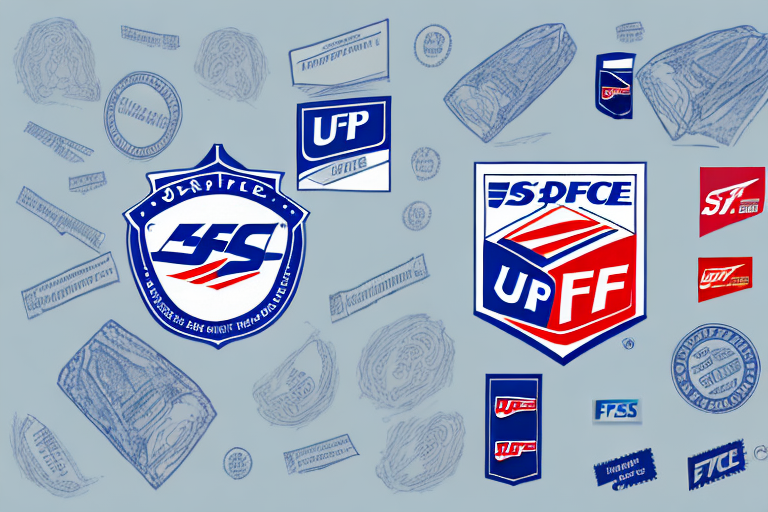Comparing USPS, FedEx, and UPS Shipping Rates
Shipping is an essential aspect of running a business, and choosing the right carrier is a crucial decision. The top three shipping carriers in the United States are the United States Postal Service (USPS), Federal Express (FedEx), and United Parcel Service (UPS). Each of these carriers has its advantages, disadvantages, and pricing structures. This article will compare and contrast USPS, FedEx, and UPS shipping rates to help businesses make an informed decision when selecting a carrier.
Introduction to USPS, FedEx, and UPS
USPS, FedEx, and UPS are the three major shipping carriers operating in the United States. USPS is a federal agency that delivers mail, packages, and other services to both domestic and international destinations. In contrast, FedEx and UPS are private companies that focus solely on shipping and logistics services.
Founded in 1775, USPS has a long history of delivering mail and packages to Americans. They offer a variety of services, including Priority Mail, First-Class Mail, and Media Mail. USPS also provides international shipping options such as Priority Mail International and First-Class Mail International.
FedEx and UPS were both established in the 20th century and have grown to become major players in the shipping industry. They offer a range of services, including ground shipping, air shipping, and international shipping. Both companies have invested heavily in technology to enhance their logistics and tracking capabilities, enabling customers to monitor their packages in real-time.
Understanding Shipping Rates
Shipping rates are determined by various factors, including package weight, dimensions, delivery speed, and destination. These carriers also offer unique pricing structures tailored to customer needs. USPS, FedEx, and UPS each provide different pricing structures and discounts based on the volume and frequency of shipments.
External factors such as fuel prices and seasonal demand can also impact shipping rates. For example, during the holiday season, shipping rates may increase due to the high volume of packages being sent. Additionally, carriers may impose extra fees for special services like signature confirmation or insurance. It is crucial to carefully review all shipping options and associated costs before selecting a carrier and service level.
How USPS, FedEx, and UPS Determine Shipping Rates
All shipping rates are calculated based on a combination of factors, including package weight, dimensions, origin, destination, and delivery speed. USPS uses zone-based pricing, where rates are determined based on the distance between the origin and destination. Similarly, both FedEx and UPS employ zone-based pricing for their ground shipping services, considering the package's origin and destination zones.
In addition to these factors, the type of service selected by the customer plays a significant role in determining shipping rates. Expedited shipping options, such as overnight or two-day delivery, will cost more than standard shipping. Shipping rates may also vary depending on the time of year, with higher demand periods like holidays leading to increased costs.
The nature of the item being shipped can also affect shipping rates. Hazardous materials, fragile items, and oversized packages may require special handling, resulting in higher shipping costs. Some carriers also have restrictions on certain items, such as live animals or perishable goods, which can limit shipping options and influence costs.
The Pros and Cons of Using USPS for Shipping
Pros:
- Generally affordable for small, lightweight packages.
- Offers flat-rate shipping options, which can help businesses save money.
- Provides a range of shipping options, including Priority Mail, First-Class Mail, and Media Mail.
- Supplies free shipping materials like boxes and envelopes.
Cons:
- Delivery speed can be slower and less reliable for some destinations.
- Does not offer guaranteed delivery times, which can be problematic for time-sensitive shipments.
- Rates may be higher for large or heavy items compared to other carriers.
The Pros and Cons of Using FedEx for Shipping
Pros:
- Reliable and fast delivery options, including same-day and overnight delivery.
- Advanced tracking systems that allow real-time package monitoring.
- Comprehensive international shipping services.
Cons:
- Can be more expensive than USPS or UPS for certain packages.
- Strict package size and weight restrictions may result in additional fees or rejected packages.
- Higher costs for businesses requiring frequent shipments.
The Pros and Cons of Using UPS for Shipping
Pros:
- Fast and reliable delivery options, including next-day and two-day delivery.
- Extensive global network for international shipments.
- Advanced tracking and logistics management tools.
Cons:
- Can be more expensive than USPS or FedEx for some packages.
- Customer service has been criticized for responsiveness and effectiveness.
- Higher costs for shipping large or heavy items compared to USPS.
Comparing Domestic Shipping Rates for USPS, FedEx, and UPS
Domestic shipping rates for USPS, FedEx, and UPS vary based on package weight, dimensions, delivery speed, and destination. The table below illustrates the shipping rates for a 5-pound package sent from San Francisco, California, to New York City, New York:
| Carrier | Delivery Time | Cost |
|---|---|---|
| USPS Priority Mail | 2-3 days | $10.00 |
| FedEx Ground | 1-5 days | $12.20 |
| UPS Ground | 1-5 days | $14.03 |
As seen from the comparison table, USPS offers the most affordable shipping option, while FedEx and UPS rates vary depending on the selected delivery time. FedEx Ground generally provides a slightly quicker delivery time compared to USPS and UPS Ground.
Comparing International Shipping Rates for USPS, FedEx, and UPS
International shipping rates for USPS, FedEx, and UPS vary based on package weight, dimensions, delivery speed, and destination. The table below compares the shipping rates for a 5-pound package sent from San Francisco, California, to Toronto, Canada:
| Carrier | Delivery Time | Cost |
|---|---|---|
| USPS Priority Mail International | 6-10 days | $45.95 |
| FedEx International Economy | 2-5 days | $156.23 |
| UPS Worldwide Expedited | 2-5 days | $137.67 |
From the comparison table, USPS is the most affordable option for international shipping, while FedEx and UPS rates are significantly higher. This can be a challenge for businesses that frequently ship international packages.
Which Carrier Offers the Best Value for Your Money?
The carrier that offers the best value for your money depends on your business's specific shipping needs:
- USPS: Best for shipping small, lightweight packages cost-effectively.
- FedEx: Ideal for businesses requiring fast and reliable shipping with advanced tracking capabilities.
- UPS: Suitable for businesses that need extensive international shipping options and reliable delivery times.
It's essential to consider all factors, including cost, delivery speed, package size, and destination, when choosing the right carrier for your business.
Which Carrier Is the Fastest for Domestic Shipping?
FedEx is often considered the fastest option for domestic shipping, offering services like same-day and overnight delivery. However, both USPS and UPS provide express shipping options that can deliver packages within similar timeframes, depending on the package's weight and dimensions.
Which Carrier Is the Fastest for International Shipping?
For international shipping, FedEx and UPS are the fastest options, with delivery times ranging from 1-5 days, depending on the destination. These carriers also offer comprehensive tracking and customs handling services, ensuring quicker and more reliable international deliveries.
How to Save Money on Shipping with USPS, FedEx, and UPS
Businesses can implement several strategies to reduce shipping costs when using USPS, FedEx, and UPS:
- Compare Prices: Regularly compare shipping rates among carriers to find the most cost-effective option for each shipment.
- Utilize Discounts: Take advantage of volume-based discounts and negotiated rates offered by carriers for frequent shippers.
- Use Flat-Rate Shipping: Opt for flat-rate shipping options when applicable to simplify costs and potentially save money.
- Optimize Packaging: Use appropriately sized packaging to reduce weight and dimensions, which can lower shipping costs.
- Automate Shipping Processes: Implement shipping software that integrates with carrier APIs to streamline processes and identify the best rates automatically.
Hidden Costs to Consider When Choosing a Carrier
When selecting a shipping carrier, it's important to be aware of potential hidden costs to avoid unexpected expenses:
- Fuel Surcharges: Additional fees based on fluctuating fuel prices.
- Delivery Area Surcharges: Extra costs for delivering to remote or hard-to-reach locations.
- Special Service Fees: Charges for services such as signature confirmation, insurance, or residential deliveries.
- Handling Fees: Costs associated with handling oversized or hazardous materials.
Thoroughly reviewing the carrier's rate sheets and service agreements can help identify and account for these hidden costs.
Tips for Choosing the Right Carrier for Your Business
When selecting the best shipping carrier for your business, consider the following factors:
- Package Weight and Dimensions: Ensure the carrier can accommodate your typical package sizes and weights.
- Delivery Speed Needed: Determine the urgency of your shipments and choose a carrier that meets your delivery time requirements.
- Destination: Consider whether you need domestic, international, or both types of shipping services.
- Frequency and Volume of Shipments: Higher volume shippers may benefit from negotiated rates and discounts.
- Cost of Shipping: Balance shipping costs with the level of service and reliability provided.
- Customer Service and Reliability: Evaluate the carrier's reputation for customer support and consistent delivery performance.
Considering these factors will help businesses make an informed decision when choosing a shipping carrier that aligns with their operational needs and budget.
Conclusion: Making the Best Choice for Your Shipping Needs
Choosing a shipping carrier is a vital decision for any business, impacting both costs and customer satisfaction. Each of the three major shipping carriers in the U.S.—USPS, FedEx, and UPS—offers distinct advantages, disadvantages, and pricing structures. When deciding on the best carrier for your business, consider factors such as package weight and dimensions, delivery speed, destination, frequency and volume of shipments, cost of shipping, and the carrier's customer service and reliability. By evaluating these elements, businesses can make an informed decision that best meets their shipping needs and enhances their overall efficiency.




















